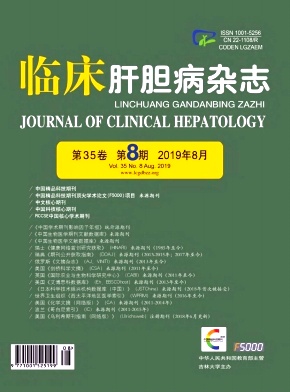|
[1] BERNARDI M, MOREAU R, ANGELI P, et al. Mechanisms of decompensation and organ failure in cirrhosis:From peripheral arterial vasodilation to systemic inflammation hypothesis[J]. J Hepatol, 2015, 63 (5) :1272-1284.
|
|
[2] PIANO S, SINGH V, CARACENI P, et al. Epidemiology, predictors and outcomes of multi drug resistant (MDR) bacterial infections in patients with cirrhosis across the world. Final results of the“Global study”[J]. Dig Liver Dis, 2018, 50 (1) :2-3.
|
|
[3] SEBASTIAN M, JUAN M, MELISA D, et al. Spontaneous bacterial peritonitis in patients with cirrhosis:Incidence, outcomes, and treatment strategies[J]. Hepat Med, 2019, 11:13-22.
|
|
[4] WIEST R, LAWSON M, GEUKING M. Pathological bacterial translocation in liver cirrhosis[J]. J Hepatol, 2014, 60 (1) :197-209.
|
|
[5] ALEXOPOULOU A, AGIASOTELLI D, VASILIEVA L, et al.Bacterial translocation markers in liver cirrhosis[J]. Ann Gastroenterol, 2017, 30 (5) :486-497.
|
|
[6] PIANO S, BROCCA A, MARESO S, et al. Infections complicating cirrhosis[J]. Liver Int, 2018, 38 (Suppl 1) :126-133.
|
|
[7] LACHAR J, BAJAJ J. Changes in the microbiome in cirrhosis and relationship to complications:Hepatic encephalopathy, spontaneous bacterial peritonitis, and sepsis[J]. Semin Liver Dis, 2016, 36 (4) :327-330.
|
|
[8] MOHD T, PIYUSH M. Immune dysfunction in cirrhosis[J]. J Clin Transl Hepatol, 2017, 5 (1) :50-58.
|
|
[9] NIU B, KIM B, LIMKETKAI B, et al. Mortality from spontaneous bacterial peritonitis among hospitalized patients in the USA[J]. Dig Dis Sci, 2018, 63 (5) :1327-1333.
|
|
[10] WANG Y, ZHANG QY. Analysis of risk factors for patients with liver cirrhosis complicated with spontaneous bacterial peritonitis[J]. Iran J Public Health, 2018, 47 (12) :1883-1890.
|
|
[11] European Association for the Study of the Liver. EASL clinical practice guidelines for the management of patients with decompensated cirrhosis[J]. J Hepatol, 2018, 69 (2) :406-460.
|
|
[12] NA S, KIM E, NAM E, et al. Comparison of clinical characteristics and outcomes of spontaneous bacterial peritonitis and culture negative neutrocytic ascites[J]. Scand J Gastroenterol, 2017, 52 (2) :199-203.
|
|
[13] THOMSON M, TAPPER E, LOK A. Dos and don’ts in the management of cirrhosis:A view from the 21st century[J].Am J Gastroenterol, 2018, 113 (7) :927-931.
|
|
[14] GRANITO A, BOLONDI L. Non-transplant therapies for patients with hepatocellular carcinoma and Child-Pugh-Turcotte class B cirrhosis[J]. Lancet Oncol, 2017, 18 (2) :e101-e112.
|
|
[15] LEE S, SAXINGER L, MA M, et al. Bacterial infections in acute variceal hemorrhage despite antibiotics-a multicenter study of predictors and clinical impact[J]. United European Gastroenterol J, 2017, 5 (8) :1090-1099.
|
|
[16] FIORE M, MARAOLO A, GENTILE I, et al. Current concepts and future strategies in the antimicrobial therapy of emerging gram-positive spontaneous bacterial peritonitis[J]. World J Hepatol, 2017, 9 (30) :1166-1175.
|
|
[17] SHIZUMA T. Spontaneous bacterial and fungal peritonitis in patients with liver cirrhosis:A literature review[J]. World J Hepatol, 2018, 10 (2) :254-266.
|
|
[18] JONES SR. The absolute granulocyte count in ascites fluid:An aid to the diagnosis of spontaneous bacterial peritonitis[J]. West J Med, 1977, 126 (5) :344-346.
|
|
[19] HOEFS JC, CANAWATI HN. Spontaneous bacterial peritonitis[J]. Hepatology, 1982, 2 (4) :399-407.
|
|
[20] RIMOLA A, GARCIA T. Diagnosis, treatment and prophylaxis of spontaneous bacterial peritonitis:A consensus document. International Ascites Club[J]. J Hepatol, 2000, 32 (1) :142-153.
|
|
[21] RUNYON B. Management of adult patients with ascites due to cirrhosis:An update[J]. Hepatology, 2009, 49 (6) :2087-2107.
|
|
[22] SONG YY, JIANG YY. Research advances in diagnosis and treatment of spontaneous bacterial peritonitis[J]. J Clin Hepatol, 2016, 32 (6) :1188-1191. (in Chinese) 宋媛媛, 江宇泳.自发性细菌性腹膜炎诊断与治疗的研究进展[J].临床肝胆病杂志, 2016, 32 (6) :1188-1191.
|
|
[23] SCHWABL P, BUCSICS T, SOUCEK K, et al. Risk factors for development of spontaneous bacterial peritonitis and subsequent mortality in cirrhotic patients with ascites[J]. Liver Int, 2015, 35 (9) :2121-2128.
|
|
[24] YANG Y, LI L, QU C, et al. Diagnostic accuracy of serum procalcitonin for spontaneous bacterial peritonitis due to endstage liver disease:A meta-analysis[J]. Medicine (Baltimore) , 2015, 94 (49) :e2077.
|
|
[25] SU D, ZHUO C, LIAO K, et al. Value of serum procalcitonin levels in predicting spontaneous bacterial peritonitis[J]. Hepatogastroenterology, 2013, 60 (124) :641-646.
|
|
[26] BURRI E, SCHULTE F, MUSER J, et al. Measurement of calprotectin in ascitic fluid to identify elevated polymorphonuclear cell count[J]. World J Gastroenterol, 2013, 19 (13) :2028-2036.
|
|
[27] LUTZ P, PFARR K, NISCHALKE H, et al. The ratio of calprotectin to total protein as a diagnostic and prognostic marker for spontaneous bacterial peritonitis in patients with liver cirrhosis and ascites[J]. Clin Chem Lab Med, 2015, 53 (12) :2031-2039.
|
|
[28] LEE S, MIN H, CHOI J, et al. Usefulness of ascitic fluid lactoferrin levels in patients with liver cirrhosis[J]. BMC Gastroenterol, 2016, 16 (1) :132.
|
|
[29] HIRAYUKI E, SHINICHI I, AKIO M, et al. Diagnosis of spontaneous bacterial peritonitis and an in situhybridization approach to detect an “unidentified” pathogen[J]. Int J Hepatol, 2014, 2014:634617.
|
|
[30] WANG H, LI Y, ZHANG FF, et al. Combination of PCT, sNFI and dCHC for the diagnosis of ascites infection in cirrhotic patients[J]. BMC Infect Dis, 2018, 18 (1) :389.
|
|
[31] MOUSA N, BESHEER T, ABDEL-RAZIK A, et al. Can combined blood neutrophil to lymphocyte ratio and C-reactive protein be used for diagnosis of spontaneous bacterial peritonitis?[J]. Br J Biomed Sci, 2018, 75 (2) :71-75.
|







 DownLoad:
DownLoad: